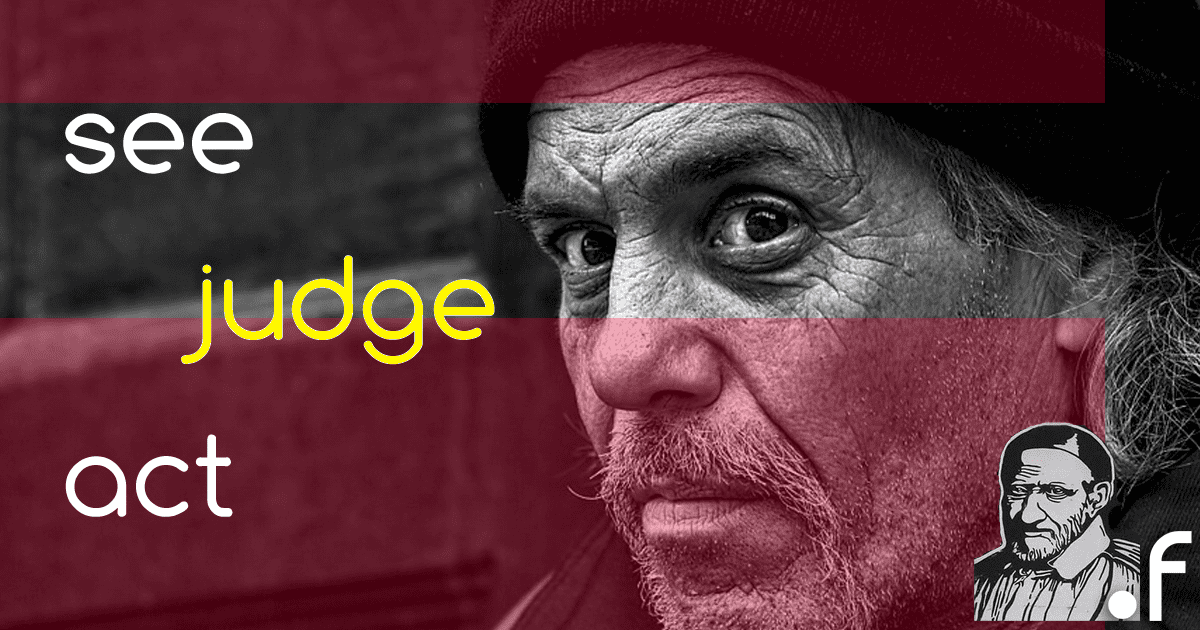The difference a lens makes

“Seeing” calls for “judging.” But judging presupposes a lens!
“Two men looked out from prison bars, one saw mud, the other stars!” This quote, variously attributed, seems to express that what one sees depends greatly upon one’s mental model and expectations.
An earlier posted based on an article by Fr. Emeric Amyot on the method of “see – judge – act” recounted that Vincent saw and understood his experiences with a dying peasant and a sick family as experiences of the broader realities of spiritual and physical poverty.
This post reflects on the impact of the mental model Vincent learned from Jesus had on how he judged situations.
The quote above highlights the difference between two ways of viewing all forms of poverty through the lens of “this is just the way things are” or “the way Jesus saw things.”
Jesus saw things differently and asked his disciples to look at their experience through the lens of the vision he offered – the vision of the kingdom of God.
What happens if we stand with Jesus in his shoes and look through his eyes?
The disciples on the road to Emmaus provide us a “before” and “after” of their experience of the “fact” of Jesus’ crucifixion.
Father Tom McKenna recently wrote of their experience…
Follow this progression in the Emmaus travelers:
– “What do you see?”They see ruin, disaster, awful disappointment, confusion, nothing making sense, all fallen apart, no real meaning left in life.
– “Let me help you to look at these same things, but through another lens.”The stranger rearranges the Scriptures, (up until now all in a heap, illuminating little and inspiring less) so that things begin to come together.The disciples catch his drift and a deeper pattern begins to appear. They start to see a larger backdrop to all the happenings around Jesus – and indeed in the happenings around them. Light dawns.
Looking through another lens .. light dawns!
– “I’ll take your kind invitation and join you for a meal.” Things are getting not only brighter, but even a bit warmer.
– “Let me do something that will open your eyes (and hearts) to the meaning of your sharing in that Passover meal last week with the Master.” And in the breaking of the bread, the stranger is revealed for who He is. And the previous days and all the years before that snap into focus. It all comes clear. And then he vanishes.
– And the rest is the apostolic Church.
What was the lens Vincent used as he reflected on what he saw?
Actually, he used the bifocal lenses of Mt 25 and Luke 4.
“Amen I say to you whatever you did for one of these least brothers or sisters of mine, you did for me (Matthew 25:31-46). COMMUNITY
“The Spirit of the Lord is upon me, because he has anointed me to bring glad tidings to the poor. (Luke 4:18-22) MISSION
In the process of systemic change we are on a similar journey.
… we’re all on the Emmaus road, sometimes at the beginning of the conversation with the annoying stranger wondering how he could be so dense, sometimes a little later at the “Aha” moment of that’s how it fits together, other times at the fellowship table when our hearts start to warm, and still others toward the end of the meal when in some breaking-of-the-bread action, that fiery realization sets in.
Emmaus sets out a faith-pattern we can all recognize, going from darkness and cloudiness through gradual clearing and then to sharp shadows – and back again.
What a difference a lens makes!
It is also the pattern of the journey through systemic change.
What mental models do I use in evaluating my experiences of the various forms of poverty today? “The way it is model” or the “Jesus lens?” The Vincentian heritage uses the Jesus lens.
Looking through the lenses of Mt. 25 and Luke 4 Vincent was led to ask the classical Vincentian question, “What must I do” Is there a way to change the system?”
Is there a way to change the system? How can I help others to see the root causes and judge long term solutions?
To be continued with “And what now for us as we face the spiritual and physical poverty of our times?” from the source article by Fr. Emeric Amyot To see and to discern the present day challenges from the perspective of Saint Vincent.







0 Comments